Properties
| Storage Buffer | PBS pH 7.4, 50% glycerol, 0.09% Sodium azide *Storage buffer may change when conjugated |
| Storage Temperature | -20ºC, Conjugated antibodies should be stored according to the product label |
| Shipping Temperature | Blue Ice or 4ºC |
| Purification | Protein G Purified |
| Clonality | Monoclonal |
| Clone Number | 10A10 |
| Isotype | IgG1 |
| Specificity | Specific for Acrolein modified proteins. Does not detect free acrolein. Does not cross-react with Crotonaldehyde, Hexanoyl Lysine, 4-Hydroxy-2-hexenal, 4-Hydroxy nonenal, Malondialdehyde, or Methylglyoxal modified proteins. |
| Cite This Product | StressMarq Biosciences Cat# SMC-505, RRID: AB_2702729 |
| Certificate of Analysis | A 1:1000 dilution of SMC-505 was sufficient for detection of Acrolein in 2 µg of Acrolein conjugated to BSA by ECL immunoblot analysis using Goat Anti-Mouse IgG:HRP as the secondary Antibody. |
Biological Description
| Alternative Names | Acrolein modified protein Antibody, Acrolein conjugated protein Antibody, 2-Propen-1-one Antibody, 2-propenal Antibody, Acraldehyde Antibody, Acrolein Antibody, Acrylic aldehyde Antibody, Protein-bound Acrolein Antibody |
| Research Areas | Alzheimer's Disease, Cancer, Lipid peroxidation, Neurodegeneration, Neuroscience, Oxidative Stress |
| Scientific Background | Lipid peroxidation occurs when oxidizing agents attack carbon-carbon double bonds found in unsaturated lipids. In addition to membrane degradation, oxidation end-products have been found to damage cell viability through their mutagenic and toxic properties. These downstream functional consequences facilitate the development of disease and premature aging. Acrolein is an electrophilic conjugated aldehyde that is a terminal product of lipid peroxidation. Acrolein is highly mutagenic and reacts with nucleophilic functional groups in DNA and proteins such as cysteine, histidine, and lysine residues (1). |
| References | 1. Takabe, W. et al. (2001) Carcinogenesis. 22 (6): 935-941 |
Product Images
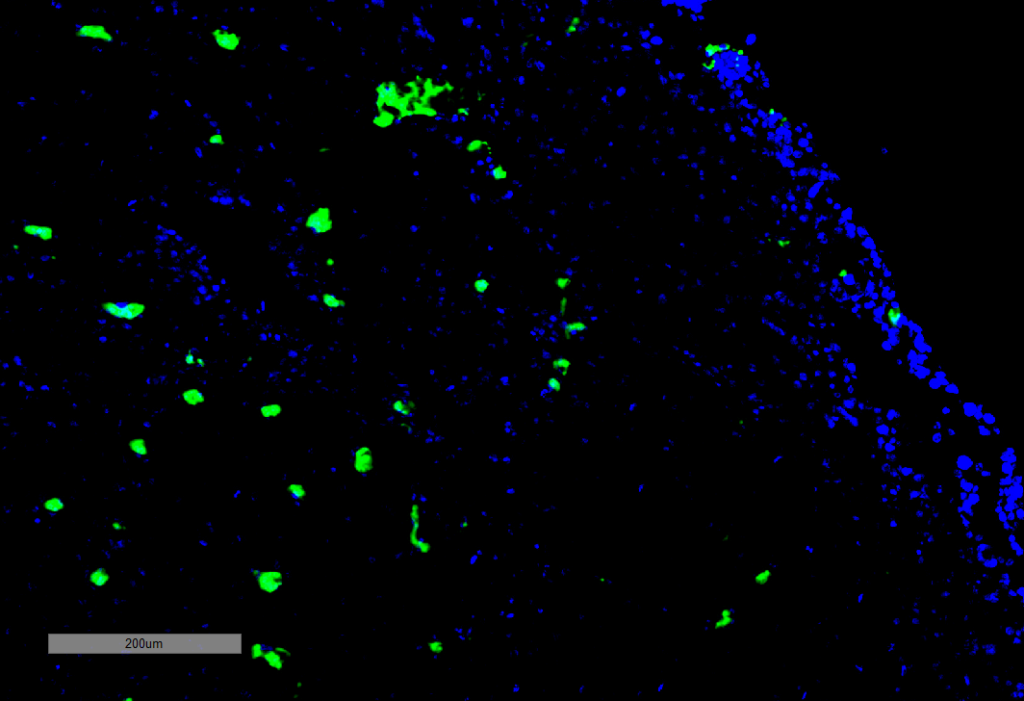
Immunohistochemistry analysis using Mouse Anti-Acrolein Monoclonal Antibody, Clone 10A10 (SMC-505). Tissue: Adrenal Carcinoma. Species: Human. Primary Antibody: Mouse Anti-Acrolein Monoclonal Antibody (SMC-505) at 1:100 for Overnight at 4C, then 30 min at 37C. Secondary Antibody: Goat Anti-Mouse IgG (H+L): FITC for 45 min at 37C. Counterstain: DAPI for 3 min at RT. Magnification: 5X.
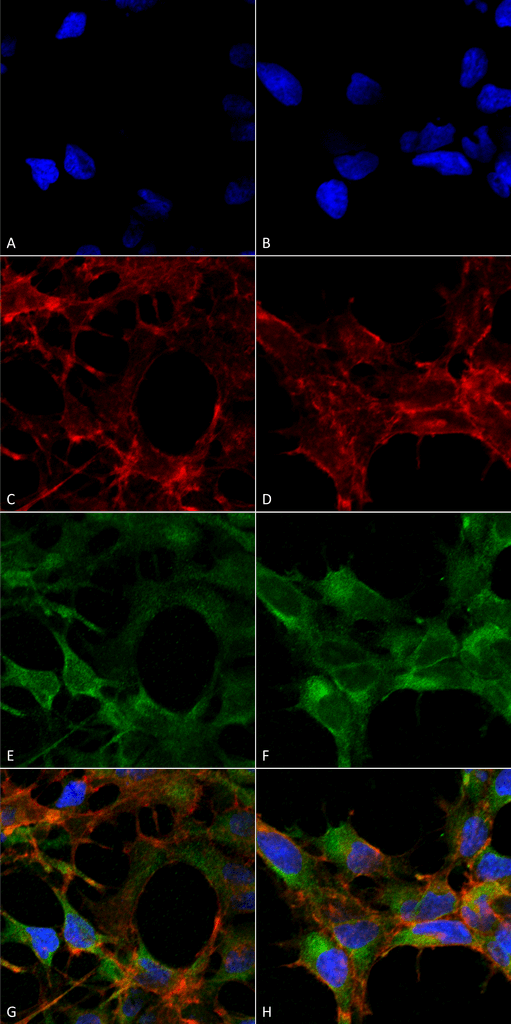
Immunocytochemistry/Immunofluorescence analysis using Mouse Anti-Acrolein Monoclonal Antibody, Clone 10A10 (SMC-505). Tissue: Embryonic kidney epithelial cell line (HEK293). Species: Human. Fixation: 5% Formaldehyde for 5 min. Primary Antibody: Mouse Anti-Acrolein Monoclonal Antibody (SMC-505) at 1:50 for 30-60 min at RT. Secondary Antibody: Goat Anti-Mouse Alexa Fluor 488 at 1:1500 for 30-60 min at RT. Counterstain: Phalloidin Alexa Fluor 633 F-Actin stain; DAPI (blue) nuclear stain at 1:250, 1:50000 for 30-60 min at RT. Magnification: 20X (2X Zoom). (A,C,E,G) – Untreated. (B,D,F,H) – Cells cultured overnight with 50 µM H2O2. (A,B) DAPI (blue) nuclear stain. (C,D) Phalloidin Alexa Fluor 633 F-Actin stain. (E,F) Acrolein Antibody. (G,H) Composite. Courtesy of: Dr. Robert Burke, University of Victoria.
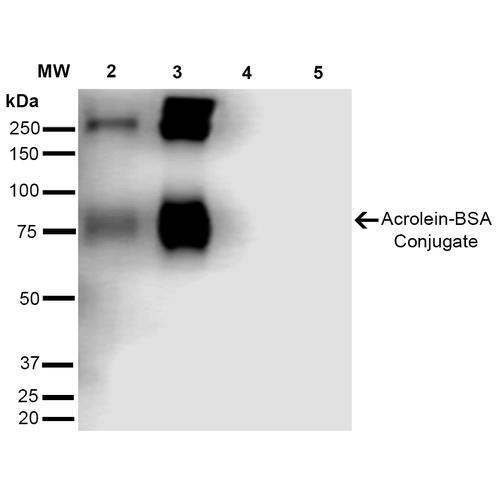
Western Blot analysis of Acrolein-BSA Conjugate showing detection of 67 kDa Acrolein protein using Mouse Anti-Acrolein Monoclonal Antibody, Clone 10A10 (SMC-505). Lane 1: Molecular Weight Ladder (MW). Lane 2: AcroleinBSA (0.5 µg). Lane 3: AcroleinBSA (2.0 µg). Lane 4: BSA (0.5 µg). Lane 5: BSA (2.0 µg). Block: 5% Skim Milk in TBST. Primary Antibody: Mouse Anti-Acrolein Monoclonal Antibody (SMC-505) at 1:1000 for 2 hours at RT. Secondary Antibody: Goat Anti-Mouse IgG: HRP at 1:2000 for 60 min at RT. Color Development: ECL solution for 5 min in RT. Predicted/Observed Size: 67 kDa.
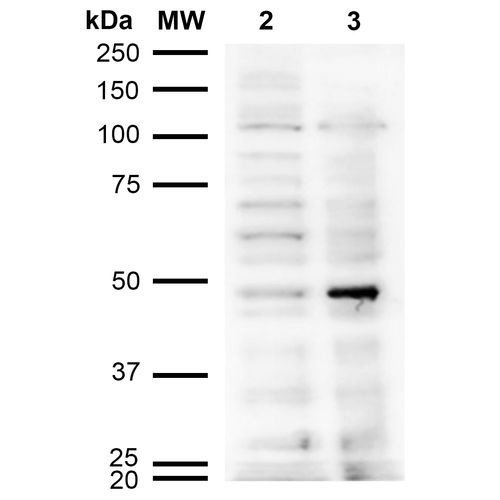
Western Blot analysis of Human Cervical cancer cell line (HeLa) lysate showing detection of Acrolein protein using Mouse Anti-Acrolein Monoclonal Antibody, Clone 10A10 (SMC-505). Lane 1: Molecular Weight Ladder (MW). Lane 2: HeLa cell lysate. Lane 3: H2O2 treated HeLa cell lysate. Load: 12 µg. Block: 5% Skim Milk in TBST. Primary Antibody: Mouse Anti-Acrolein Monoclonal Antibody (SMC-505) at 1:1000 for 2 hours at RT. Secondary Antibody: Goat Anti-Mouse IgG: HRP at 1:2000 for 60 min at RT. Color Development: ECL solution for 5 min in RT.
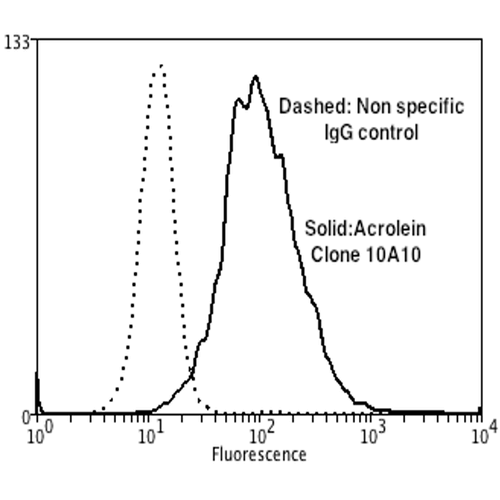
Flow Cytometry analysis using Mouse Anti-Acrolein Monoclonal Antibody, Clone 10A10 (SMC-505). Tissue: Neuroblastoma cells (SH-SY5Y). Species: Human. Fixation: 90% Methanol. Primary Antibody: Mouse Anti-Acrolein Monoclonal Antibody (SMC-505) at 1:50 for 30 min on ice. Secondary Antibody: Goat Anti-Mouse: PE at 1:100 for 20 min at RT. Isotype Control: Non Specific IgG. Cells were subject to oxidative stress by treating with 250 µM H2O2 for 24 hours.

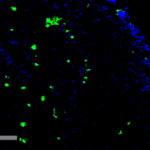
![Mouse Anti-Acrolein Antibody [10A10] used in Immunocytochemistry/Immunofluorescence (ICC/IF) on Embryonic kidney epithelial cell line (HEK293) (SMC-505)](https://www.stressmarq.com/wp-content/uploads/SMC-505_Acrolein_Antibody_10A10_ICC-IF_Human_Embryonic-kidney-cells-HEK293_Composite_1-100x100.png)
![Mouse Anti-Acrolein Antibody [10A10] used in Western Blot (WB) on Acrolein-BSA Conjugate (SMC-505)](https://www.stressmarq.com/wp-content/uploads/SMC-505_Acrolein_Antibody_10A10_WB_Acrolein-BSA-Conjugate_1-100x100.png)
![Mouse Anti-Acrolein Antibody [10A10] used in Flow Cytometry (FCM) on Human Neuroblastoma cells (SH-SY5Y) (SMC-505)](https://www.stressmarq.com/wp-content/uploads/SMC-505_Acrolein_Antibody_10A10_FCM_Human_Neuroblastoma-cells-SH-SY5Y_1-100x100.png)
![Mouse Anti-Acrolein Antibody [10A10] used in Western Blot (WB) on Cervical cancer cell line (HeLa) lysate (SMC-505)](https://www.stressmarq.com/wp-content/uploads/SMC-505_Acrolein_Antibody_10A10_WB_Human_Cervical-Cancer-cell-line-HeLa_1-100x100.png)




















Seth :
We switched to the StressMarq antibody from another company and are very happy with it. I have used it for multiple applications. The first is use in rat spinal cord contusion injury, where we are trying novel approaches to remove acrolein as a therapeutic intervention post injury. Tissue is fixed for 1-2 days in 4% PFA then frozen in OCT and stored at -80C. I haven’t done an IF stain, but shows up nicely using DAB and amplifying the signal with an ABC kit. Also works very nicely with western blot, seeing bands in the 75kDa to 250kDa range, in brain and spinal cord lysates.